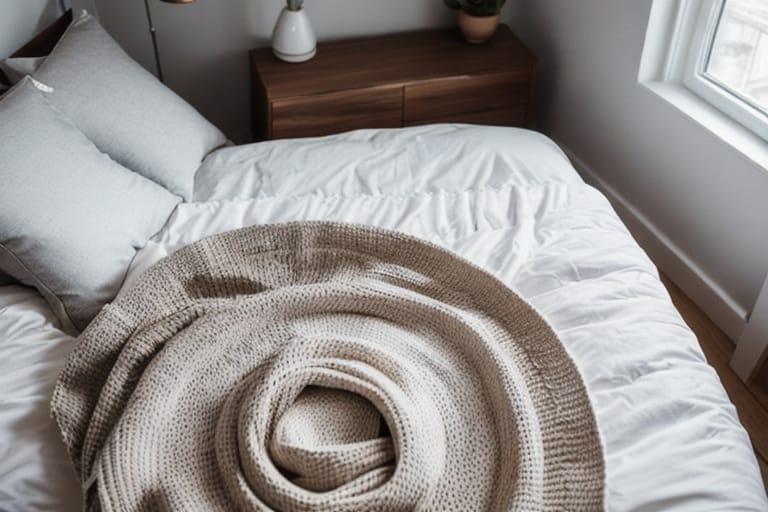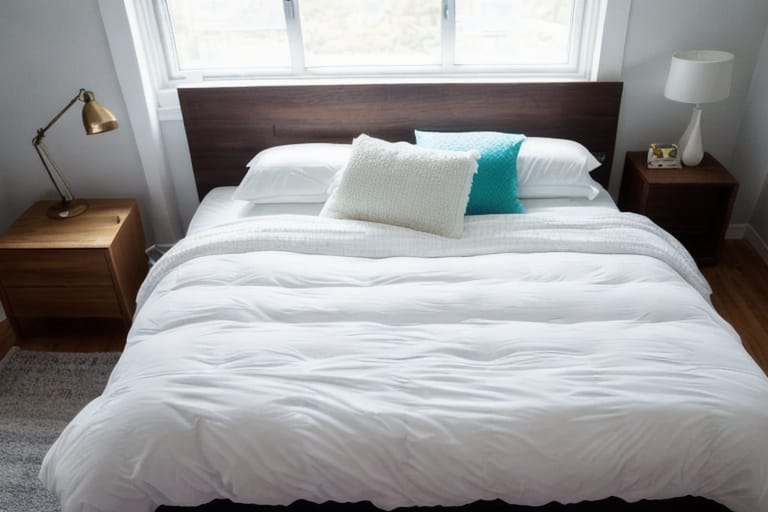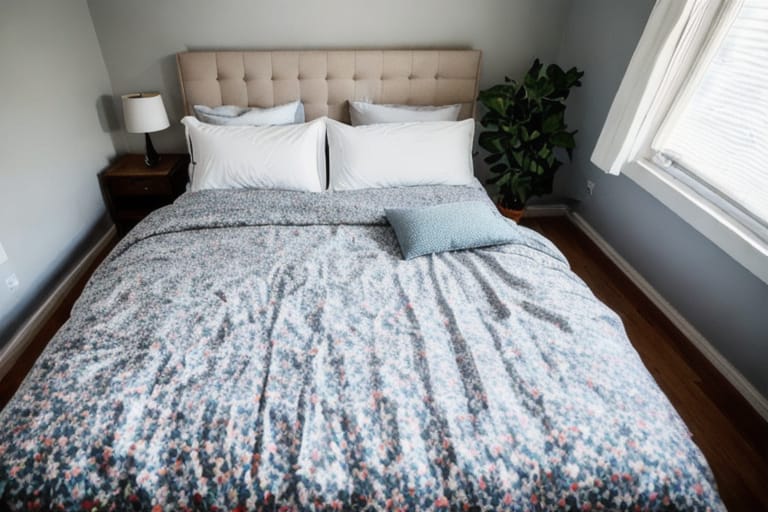Are you looking to upgrade your bedding to a fluffier, more luxurious down comforter? Getting wrapped up in a comforting cloud of plushness sounds pretty nice, doesn’t it?
But with so many options on the market, it can be tricky to determine exactly what fills that “soft and airy,” “warm and plush bedding” ideal. In this beginner’s guide, we’ll walk through everything you need to know to find your perfect down comforter.
A Down Comforter Offers Unbeatable Softness and Insulation
A down comforter is filled with the fluffy undercoating found beneath the exterior feathers of ducks and geese. This natural fill material offers:
- The plush hand feel – Ultra-soft and airy
- Warmth without weight – Provides cozy insulation without being heavy
- Loft and breathability – Fluffy while allowing airflow
Down alternative comforters can simulate some of the same sensations using synthetic fills like microfiber. But for superb insulating properties that lend a true “Cadillac of duvet materials” luxury, nothing beats real goose or duck down.
What Is Down Fill Made Of?
Beneath the exterior feathers of ducks and geese, there is a layer of fluffy insulation consisting of down clusters mixed with tiny feathers called plumules.
Down clusters have a three-dimensional structure that traps air, providing excellent insulation. The clusters consist of thousands of individual filaments that align themselves into formation naturally with movement and air exposure.
These soft filaments lack rigid quills and shafts present in regular feathers, lending an ultra-plush hand feel. Goose down tends to be more desirable than duck down based on fill power (see Fill Power section). But both impart the sought-after cloud-like sensation of high-quality down comforters.
Differences: Duck Down vs Goose Down Fill
Goose down tends to be more desirable and higher-valued over duck down when used as a comforter fill. Here are some of the key differences:
Goose Down
- Larger down clusters
- Higher fill power – more loft and insulation per ounce
- Softer and more resilient filaments
Duck Down
- Smaller down clusters
- Lower fill power – less efficient insulation
- Stiffer filaments with more quill-like pieces
However, comforters with premium duck down can still be very lofty and comfortable. And they tend to cost less than comparable goose-down comforters. So duck down can provide an attractive budget-friendly alternative.
Fill Power Matters More Than You Might Think
When choosing a down comforter, fill power is one of the most important metrics to understand. This measures the insulating properties and quality of the raw down used as fill material.
Fill power is represented by a numerical value based on cubic inches per ounce. So a fill power of 600 means one ounce of that down will expand to fill 600 cubic inches when fully lofted.
- Higher fill-power down will be lighter and more efficient at trapping heat based on weight.
- Lower fill-power-down will be heavier and bulkier for the amount of warmth provided.
For a lightweight down comforter that still feels decadently plush, a fill power of 600 or higher offers a nice sweet spot. Premium comforters feature fills exceeding 700+ fill power.
Finding the Right Warmth Level
Down comforters are available in a wide range of warmth ratings to match your personal sleep preferences. Consider factors like:
- Your naturally warm or cool sleep tendencies
- The climate/season where you live
- Whether you need cooling or added insulation
- If you’ll use additional blankets or prefer just the comforter
Here are some typical warmth level ratings for down comforters:
Summer Weight: Great for hot sleepers. Extremely breathable and lightweight.
All-Season: Provides versatility across seasons. Warmth can be adjusted easily.
Winter Weight: Offers maximum insulation and coziness for cold weather. The warmest option.
Getting a comforter with adjustability allows customizing the warmth as needed by adding a lightweight blanket or duvet as your sleep system.
Fill Power Comparisons
| Fill Power | Pros | Cons | |
|---|---|---|---|
| Under 500 | Low-range | Most affordable cost | Less fluffy, less warm |
| 500 – 599 | Mid-range | Balances cost and quality | Noticeable in plushness |
| 600 – 699 | Good mid/upper range | Soft, warm, nicely lofty | Higher price tag |
| 700 – 799 | High-end | Luxuriously plush and insulating | Expensive, delicate |
| 800+ | Ultra premium | “Absolute highest quality” | Very pricey, extremely delicate |
- As shown in the table, higher fill power comes with an exponential increase in cost. But also a similar exponential increase in luxury feel, loftiness, and efficient insulation.
- Depending on your budget, and desired balance of affordability vs exceptional quality, 600-699 tends to offer the best bang for your buck in a mid/upper range fill power. The plush soft sensation is very noticeable over lower fill powers options.

Pick Fabrics for Comfort, Durability, and Value
Beyond fill material, an outer shell fabric makes up the other key component impacting comforter performance and feel.
Popular shell fabrics include:
Egyptian Cotton – Ultra luxurious long fibers; exceptionally soft
Pima Cotton – Made in the USA; smooth, durable, and breathable
Sateen Weave – Lightweight silkiness; luminous sheen
Percale Weave – Cool and crisp; lightweight durability
Damask Stripes – Textured dimensional woven patterns
Typically cost and quality rise together regarding outer shell fabrics. Premium options like long-staple Egyptian cotton offer exceptional softness through added care and labor-intensive production. High-end thread counts exceeding 500 also increase the cost.
However, today more comforters use blended fabrics with Pima cotton touches for enhanced practicality at reasonable prices. These combine pleasing aesthetics, good durability, and greater access.
Finally, always check the thread count along with weave style and fiber contents when evaluating quality. Higher thread counts signal more effort devoted to meticulous construction.
Key Comforter Sizing Reference
| Size | Dimensions* | Fits Mattress Size |
|---|---|---|
| Twin | 68″ x 86″ | Twin bed |
| Twin XL | 68″ x 92″ | Twin XL bed |
| Full/Double | 81″ x 86″ | Full/Double bed |
| Queen | 90″ x 90″ | Queen bed |
| King | 104″ x 90″ | King bed |
| California King | 108″ x 92″ | California King bed |
*Width x Length
- Comforters come in standard bed sizes to coordinate with your mattress dimensions seamlessly. Measure your mattress length and width to determine your size.
- Side drop length also varies. More premium options feature longer drop lengths – how far the sides hang over the bed for a lush hotel collection style effect.
- For ultimate luxury, adding an oversized comforter can lend a dramatic draping silhouette.
5 Factors in Finding Your Perfect Down Comforter
Choosing your ideal down comforter involves evaluating options across 5 key factors to meet your needs delightfully. Keep these top considerations in mind while shopping:
1. Warmth – Match insulation rating/seasonality rating to your typical sleeping preferences
2. Fill Power – Higher is warmer by weight; 600-699+ balances cost/quality nicely
3. Shell Fabric – Soft, smooth long staples like cotton for plush luxury
4. Size – Scale proportionally to fit your bed dimensions
5. Budget – Decide cost thresholds; fill power and fabrics impact price
Selecting options aligned across those 5 factors results in heavenly down comforter bliss. So you can snuggle up feeling like you’re sleeping on a fluffy cloud every single night!
Care Tips to Extend the Life of Your Investment
To enjoy your down comforter for many years, follow these care recommendations:
- Dry clean only – Prevents damage to delicate fibers
- Wash 2-3 times annually max – Avoid over-washing
- Natural drying while flat – Retains maximum loft
- Store off-season in breathable case – Allows fill to breathe; prevents congregation of moisture/mold
- Fluff routinely – Redistributes fill evenly to avoid clumping
With the right care matching the washing guidelines, your quality down comforter should provide a decade or longer of blissful comfort and inviting appearance.
Enjoy Affordable Luxury
While premium down comforters can run $400+, excellent mid-range options meeting rigorous quality standards are also abundantly available in the $150 to $300 range. These deliver substantial value for a reasonable outlay.
For budget-focused shoppers or those wanting spared-no-expense indulgence, rest assured quality choices exist at nearly any price threshold.
Ethical Down Sources Matter
Shop for comforters filled with down certified by the Responsible Down Standard (RDS) for ethically-sourced materials.
Conscientious consumers should seek out down certified by the Responsible Down Standard (RDS) or similar reputable organizations.
RDS protocols assure humane practices like:
- Birds are never live-plucked or force-fed
- Sourcing/supply chains are third-party audited
- Certification is species and region-specific for traceability
Choosing RDS down promotes ecologically and ethically produced materials across the comforter supply chain. Voting with your wallet encourages sustainable communities and environments worldwide.
Rest Assured with Worry-Free Warranties
Reputable down comforter brands like the Canadian Down & Feather Company stand behind their products with generous return policies and warranties. These assure your purchase against material defects and lasting performance for years to come.
Common warranties include:
- 10 or 20 Year Guarantees against manufacturing flaws causing fill to shift or leak
- 60 to 100 Night Sleep Trials allowing exchanges to get the perfect fit
- Lifetime Replacement programs for factory defects
Review fine print details before buying. But quality brands often match or exceed top retailer standards giving peace of mind. So you can rest easy on that plush new bedding investment.

Transform Your Sleep with Cozy Down Softness
Few things feel more divinely comfy than snuggling under a fresh down comforter anticipating a perfect night’s sleep ahead. As you drift off, the delicate insulation traps body heat, keeping you blissfully warm.
The fluffy fill molds lightly around your shape, imparting that signature sensation of floating on a fluffy cloud. The supple fabric caresses gently with each toss or turn through the night.
Then as dawn’s glow fills the room, you wake gradually from REM cycles completely undisturbed and refreshed in your private down cocoon. The very best mornings start the night before under the enveloping luxury of an exquisite down comforter.
Frequently Asked Questions
What is the benefit of a down comforter vs alternative?
Down comforters provide unmatched warmth for their weight. The natural fill power of fluffy goose or duck down supplies superior insulation. Meanwhile the delicate filaments feel ultra-soft against skin for a sensory experience synthetic alternatives struggle matching. So for the ultimate in lightweight, cloud-like coziness, 100% genuine down remains the “Cadillac of duvet materials.”
How do I know if my comforter is warm enough?
The warmth ratings or recommended seasons help signal the amount of insulation offered. Terms like summer, winter, or all-season indicate light, heavy, or middle insulation levels respectively. You can also match options to your typical sleep environment and whether you tend to sleep hot or cold naturally. Finally getting an adjustable fill comforter allows customizing coziness by adding blankets as needed.
What’s the difference between white down vs gray down?
Color refers to the duck or goose type rather than differences in the down itself. White down comes from mature ducks harvested after nesting season finishes. Their feathers turn white naturally with age. Meanwhile gray down derives from juvenile geese harvested prior to full maturation when colors remain grayish. Both can make exceptional comforter fills, with mature white down clusters tending to be larger and thus higher quality on average.
How often should you replace a down comforter?
With proper care like dry cleaning and air drying, a quality down comforter should last anywhere from 7-15 years depending on original make. Signs it’s time for a fresh comforter include significant shifts in fill distribution, empty unfilled patches, poking quills/feathers protruding through the shell, or visible staining/damage not remedied by cleaning attempts. Some premium brands also offer lifetime warranties against defects while guaranteeing fill power for 10 or even 20 years.
Where can I buy an ethical down comforter?
Seeking out RDS-certified down comforters or similar reputable certifications ensures your purchase didn’t use unethical sourcing practices like live-plucking or force-feeding. Brands like the Canadian Down & Feather Company audit their supply chains through third parties to guarantee humane treatment meeting established standards. Checking for proof like RDS certification aligns your values and luxury comforter purchase.








